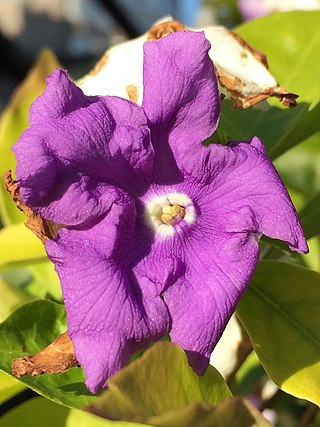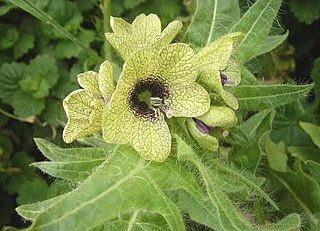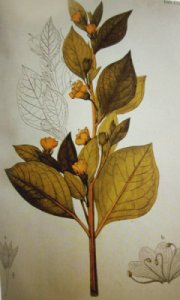
Atropa is a genus of flowering plants in the nightshade family, Solanaceae: tall, calcicole, herbaceous perennials, bearing large leaves and glossy berries particularly dangerous to children, due to their combination of an attractive, cherry-like appearance with a high toxicity. Atropa species favour temperate climates and alkaline soils, often growing in light shade in woodland environments associated with limestone hills and mountains. Their seeds can remain viable in the soil for long periods, germinating when the soil of sites in which plants once grew is disturbed by human activity or by natural causes, e.g. the windthrow of trees. The best-known member of the genus Atropa is deadly nightshade – the poisonous plant par excellence in the minds of many. The pharmacologically active ingredients of Atropa species include atropine, scopolamine, and hyoscyamine, all tropane alkaloids having anticholinergic, deliriant, antispasmodic and mydriatic properties. The genus is named for Άτροπος (Atropos) – lit. 'she who may not be turned (aside)' – one of the Three Fates and cutter of the thread of life / bringer of death – in reference to the extreme toxicity of A.belladonna and its fellow species – of which four others are currently accepted.

Atropa bella-donna, commonly known as deadly nightshade or belladonna, is a toxic perennial herbaceous plant in the nightshade family Solanaceae, which also includes tomatoes, potatoes and aubergine (eggplant). It is native to Europe and Western Asia, including Turkey, its distribution extending from England in the west to western Ukraine and the Iranian province of Gilan in the east. It is also naturalised or introduced in some parts of Canada, North Africa and the United States.

A besom is a broom, a household implement used for sweeping. The term is mostly reserved for a traditional broom constructed from a bundle of twigs tied to a stout pole. The twigs used could be broom, heather or similar. The song "Buy Broom Buzzems" from Northern England refers to both types of twig. From the phrase broom besom the more common broom comes. In Scotland and Bulgaria, besoms are still occasionally to be found at the edge of forests where they are stacked for use in early response to an outbreak of fire.

Nicandra physalodes is a species of flowering plant in subfamily Solanoideae of the nightshade family. It is known by the common names apple-of-Peru and shoo-fly plant. It is thought originally to have been native to western South America, including Peru, and is known elsewhere as an introduced and ruderal species – sometimes as a weed – in tropical, subtropical and, to a lesser extent, temperate areas all over the world. It has also long been cultivated as an ornamental plant for its attractive flowers and curious fruits and has been adopted into the traditional medicine of countries far-removed from its original home.

Anisodus is a genus of flowering plants in the family Solanaceae.

Brunfelsia is a genus of flowering plants belonging to subfamily Petunioideae of the nightshade family Solanaceae. The 50 or so species have been grouped into the three sections: Brunfelsia, Franciscea and Guianenses, which differ significantly in both distribution and characteristics, although molecular data have revealed that only two sections are natural (monophyletic), namely the Caribbean section Brunfelsia and a common section for all South American species. Linnaeus named the genus for the early German herbalist Otto Brunfels (1488–1534).

Anisodus tanguticus is a species of flowering plant belonging to tribe Hyoscyameae of subfamily Solanoideae of the nightshade family Solanaceae. It is thus closely related to Henbane and Deadly Nightshade. Solanaceae is a plant family which includes many important agricultural plants such as the potato and the tomato. It is mostly found growing in the Qinghai-Tibetan Plateau. A. tanguticus is collected and used mostly for its medicinal effects caused by the plant's biologically active nicotine and tropane alkaloids. It has a significant impact in China as one of the 50 fundamental herbs used in traditional Chinese medicine.

Iochroma arborescens is a species of flowering plant in the genus Iochroma, belonging to the nightshade family Solanaceae. Formerly it was considered the single species in the monotypic genus Acnistus. Common names include gallinero, mata-gallina, fruta-de-sabiá, hollowheart, wild tobacco, siyou, bastard sirio, galán arbóreo, tabaco de monte, nigüito, marieneira, güitite, and tabak djab.

Scopolia japonica, also Japanese belladonna or Korean scopolia, is a flowering plant species in the genus Scopolia - one of the eight genera in tribe Hyoscyameae of the nightshade family Solanaceae.

Scopolia carniolica, the European scopolia or henbane bell, is a poisonous plant belonging to tribe Hyoscyameae of the nightshade family Solanaceae. It bears dark brownish-violet nodding flowers on long, slender pedicels. It grows to 60 centimetres (24 in) in height. Its toxicity derives from its high levels of tropane alkaloids, particularly atropine. The concentration of atropine is highest in the roots.

Hyoscyameae is an Old World tribe of the subfamily Solanoideae of the flowering plant family Solanaceae. It comprises seven genera: Anisodus, Atropa, Atropanthe, Hyoscyamus, Physochlaina, Przewalskia and Scopolia. The genera Atropanthe and Przewalskia are monotypic, the first being endemic to China and the second to Tibet.

Mandragora is a plant genus belonging to the nightshade family (Solanaceae). Members of the genus are known as mandrakes. Between three and five species are placed in the genus. The one or two species found around the Mediterranean constitute the mandrake of ancient writers such as Dioscorides. Two or three further species are found eastwards into China. All are perennial herbaceous plants, with large tap roots and leaves in the form of a rosette. Individual flowers are bell-shaped, whitish through to violet, and followed by yellow or orange berries.
Mandragora turcomanica, the Turkmenian mandrake, is a perennial herbaceous plant in the family Solanaceae, native to the Köpet Dag mountains in Turkmenistan and one location in neighbouring Iran. It differs from the mandrakes found around the Mediterranean chiefly by being larger.
Mandragora caulescens, the Himalayan mandrake, is a perennial herbaceous plant in the family Solanaceae, native to the Himalayas and mountainous regions of Myanmar and south-west China. One of the differences from the other species of Mandragora is that it has a stem, whereas they are stemless. Like all species of Mandragora, it contains tropane alkaloids, making it toxic. It is used in traditional Chinese medicine.

The Solanaceae, or the nightshades, is a family of flowering plants that ranges from annual and perennial herbs to vines, lianas, epiphytes, shrubs, and trees, and includes a number of agricultural crops, medicinal plants, spices, weeds, and ornamentals. Many members of the family contain potent alkaloids, and some are highly toxic, but many—including tomatoes, potatoes, eggplant, bell, and chili peppers—are used as food. The family belongs to the order Solanales, in the asterid group and class Magnoliopsida (dicotyledons). The Solanaceae consists of about 98 genera and some 2,700 species, with a great diversity of habitats, morphology and ecology.

Atropa baetica, commonly known as the Andalusian belladonna, is one of Europe's rarest wildflowers. A close relative of the infamous deadly nightshade, its specific name derives from that of the Roman province of Hispania Baetica, while its common name refers to the Spanish region of Andalucía – both designating the area in the south of Spain where it is most frequently encountered. It is an attractive perennial plant with a herbaceous habit, bearing infundibuliform, yellow or greenish flowers and shiny, black berries. Like the other three species of Atropa, it is an extremely poisonous plant, containing a variety of tropane alkaloids with anticholinergic, deliriant, antispasmodic and mydriatic properties. Although most populations of the plant are to be found in Spain, it is not wholly confined to the Iberian Peninsula of Europe, occurring also in certain localities in Morocco and Algeria in the Atlas Mountains of North Africa. The Rif and the Baetic System, which face each other across the Alboran Sea, together constitute one of the finest of the Mediterranean biodiversity hotspots – rich in endemic species, of which Atropa baetica is a notable example..
Atropa pallidiflora is a close relative of the infamous deadly nightshade and, like it, is an extremely poisonous plant, containing a variety of tropane alkaloids valued in medicine for their anticholinergic, antispasmodic and mydriatic properties and deliriant in excess. Atropa pallidiflora is the least well-known of the four currently accepted species of Atropa and is endemic to the remarkable Caspian Hyrcanian mixed forests of Northern Iran, which can boast all the species of Atropa currently recognised, with the sole exception of the strictly Ibero-Maghrebi Atropa baetica. The binomial Atropa pallidiflora was published by Eva Schönbeck-Temesy in volume 100 ('Solanaceae') of Karl Heinz Rechinger's monumental Flora Iranica in 1972. The specific name pallidiflora signifies 'bearing flowers of a pale, wan or washed-out hue' and, while appropriate, is not especially evocative, given that the flowers of most Atropa species are far from vivid. The flowers of A. pallidiflora, like those of A.baetica, vary from greenish to yellow, but, as the designation 'having pallid flowers' might suggest, the yellow in question is a dingy greenish-yellow that is far from ornamental. The geographical term 'Hyrcanian' in the common name signifies that the plant is native to what was once the satrapy of Hyrcania, the name of which derives from an Iranian root meaning 'wolf' : Hyrcania is thus the 'Land of Wolves'. The name is an apt one, since the Hyrcanian forests have long been known as a hunting ground of legendary richness and beauty : the lush forests could support an abundance of large, mammalian herbivores, which in turn could support an abundance of apex predators - notably the wolf, but also the Persian leopard and even the tiger. The word 'Hyrcanian' will be familiar to any diligent reader of the works of William Shakespeare, as an epithet of the proverbially savage Caspian Tiger, known to the dramatist from his reading of the works of various Latin authors - who, in turn, were familiar with the Ancient Greek coinage 'Hyrcania' and the lands adjoining the Caspian Sea to which the place name referred. Regarding the richness of the Hyrcanian flora - of which Atropa pallidiflora is a noteworthy element - it is worth mentioning that the name of the modern Iranian province of Golestan has the delightful meanings of 'Rose Garden' and 'Land of Flowers'.

Petunioideae is a subfamily within the family Solanaceae.

Atropanthe is a monotypic genus of flowering plants belonging to tribe Hyoscyameae of subfamily Solanoideae of the family Solanaceae.
Poortmannia is a genus of flowering plants belonging to the family Solanaceae. It is also in Solanoideae subfamily, tribe Solandreae Miers and also subtribe Juanulloinae. The genus has only one known species, Poortmannia speciosaDrake.
























